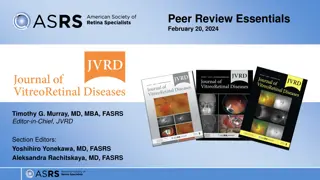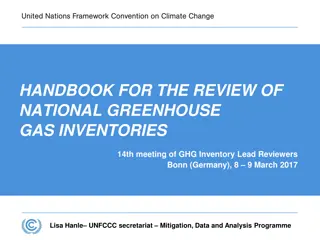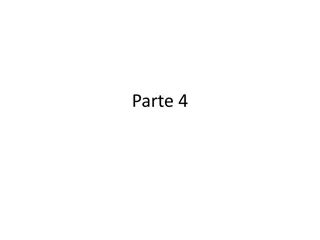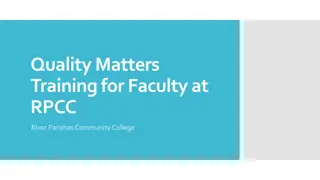Burn Therapist Certified (BT-C) Reviewer Training Program
The Burn Therapist Certified (BT-C) Reviewer Training Program aims to promote and recognize occupational and physical therapists specializing in burn rehabilitation. Reviewers are selected based on specific criteria and are required to undergo training and complete mock reviews before evaluating portfolio applications. Privacy and conflict of interest are paramount, ensuring fair and unbiased reviews. Aspiring reviewers must familiarize themselves with the handbook, complete training requirements, and adhere to agreements for a thorough preparation process.
Download Presentation

Please find below an Image/Link to download the presentation.
The content on the website is provided AS IS for your information and personal use only. It may not be sold, licensed, or shared on other websites without obtaining consent from the author. Download presentation by click this link. If you encounter any issues during the download, it is possible that the publisher has removed the file from their server.
E N D
Presentation Transcript
Burn Therapist - Certified (BT-C) Reviewer Training Professional Certification Committee
Mission The mission of the Burn Therapist Certified (BT-C) program is to promote and recognize occupational and physical therapists who have specialized knowledge, skill and experience in burn rehabilitation.
General Information for Reviewers BT-C portfolio reviewers are selected by the Professional Certification Committee (PCC) from high level applicant candidates who successfully achieved BT-C credentialing. A reviewer must meet the following criteria: Have a current BT-C certification. Have demonstrated achieving initial BT-C status with an exceptional Portfolio Presentation. Have completed BT-C Reviewer Training. Submitted a signed Reviewer Attestation and Reviewer Agreement.
Privacy and Conflict of Interest All application reviews will remain confidential. The applicant, ABA central office and PCC committee chairs will make every effort to make the portfolio application anonymous. If reviewers believe they are unable to objectively and fairly review an application for any reason, they must recuse themselves from that portfolio review. Example reasons for recusal are: Supervisor or colleague of applicant working within your institution or organization. Professor or academic relationship with applicant. You feel that you cannot provide an unbiased review.
Preparing to become an BT-C Reviewer 1) Become familiar with the Reviewer Handbook. 2) Review this Training PowerPoint Deck and complete the quiz at the end. 3) Complete mock reviews. A mock review is the review of an application designed for training only. 4) Complete shadow review(s) with mentorship from an experienced reviewer. A shadow review is completing a live Portfolio Application review along with other reviewers and receiving mentor feedback (review does not count toward applicant decision).
Preparing to become an BT-C Reviewer In addition, all reviewers must: Sign and return the Reviewer Agreement. Sign and return the Reviewer Attestation Statement. Set up Reviewer profile with ABA. You will receive a unique reviewer number. This reviewer number needs to be used when completing the review forms in lieu of a name to allow the feedback to be provided anonymously.
Invitation to Review a Portfolio Application Once you have completed your Reviewer Training, you will be sent an email inviting you to review an actual Portfolio Application when needed. Please respond to the email with confirmation that you are able to perform the review within a 3 week time frame. Portfolio reviews conducted may be counted as Professional Development Activities (PDAs) for the reviewer. Initial full BT-C portfolio application = 10 PDA credits BT-C recertification application = 5 PDA credits
Instructions for Reviewing a Portfolio Application After you accept an invitation to review a new BT-C Portfolio Application submission, you will be sent the following information: 1. Four Evidence Forms (EF) (in pdf format) that comprise the Portfolio Application and embedded links to supporting information. Note the numbering titles of the EFs and use the same numbering on your reviewer evaluation form. 2. A Formstack link to the Reviewer Evaluation Form. 3. Link to Reviewer Handbook. Reference the chosen SPOs, SPO guide for Applicant and Reviewer Criteria.
Instructions for Reviewing a Portfolio Application Step 1 Read the Portfolio Application You may print the Portfolio Application or choose to review it in electronic pdf format. You should be able to access the supporting documents provided by the applicant from the links in the pdfs. You may go back and forth to the SPO grid (Reviewer Handbook Appendix 4) to check the evaluation criteria as you read the applicant responses.
Instructions for Reviewing a Portfolio Application Step 2 Familiarize yourself with the chosen Practice Domain Standard and associated SPOs Review the Practice Domain Standard and associated SPO grid for the domains that were selected by the applicant. The SPO grid provides the reviewer evaluation criteria that you will be using to determine if the information provided by the applicant meets the standard and the specific objectives. The criteria lists specific components to look for in a response to determine if the SPO is met.
Instructions for Reviewing a Portfolio Application Step 3 Evaluate and score the BT-C Portfolio Application Using the Reviewer Evaluation Form online, select a score for each SPO. The options for scoring of each SPO are: 0 - Applicant does NOT address the criteria in the information presented. 1 - Applicant PARTIALLY addresses the criteria in the information presented. 2 - Applicant SUFFICIENLTY addresses the criteria in the information presented. If you have scored the response a 0 or 1 , please provide the applicant with feedback guiding them on what could be improved in the response. For a score of 2 comments are not required. .
Instructions for Reviewing a Portfolio Application Step 3 Evaluate and score the BT-C Portfolio Application Score each SPO based on the information included in the response. The applicant has been instructed to respond in the appropriate area for each response but sometimes information will be found in other areas of the application. Uploaded documents should be used to support the application only and the reviewer is not expected to find specific responses to the SPOs in the attachments. .
Instructions for Reviewing a Portfolio Application Step 3 Evaluate and score the BT-C Portfolio Application At the end of each EF, you will be able to provide general comments about the strengths, weakness or areas that need further clarification/description in the application. Please write them in a manner that is helpful and informative to the applicant. If the applicant decision is No or Inconclusive, the applicant will receive a copy of these comments.
Instructions for Reviewing a Portfolio Application Step 4 Provide overall recommendation for BT-C After reviewing all four EFs, you will be asked to make an overall recommendation regarding qualification for BT-C status. It is helpful to review the numeric score provided from a sum of all of the SPOs. Review this score and ensure that it reflects your overall impression of the application. Typically, applications that score below a 60% do not qualify for BT-C or require resubmission with additional information to qualify and scores above 90% are typically deemed Qualified.
Instructions for Reviewing a Portfolio Application Step 4 Provide overall recommendation for BT-C The options for BT-C recommendation are: Qualified Applicant meets certification criteria Inconclusive Applicant must resubmit application with additional information for consideration of certification status Not qualified Applicant does NOT meet criteria for certification status
Instructions for Reviewing a Portfolio Application Step 5 Submit Recommendation After you have completed all parts of the Reviewer Evaluation Form, submit the form to ABA. If at any time you need to leave the Reviewer Evaluation Form, it is important that you save your work online. Formstack will provide you with a link to re-access your Reviewer Evaluation Form and continue. You cannot retrieve your work without this link. It is recommended to save your scores and comments in an offline version when possible. If your internet connection is lost, your work will not be saved.
Instructions for Reviewing a Resubmission Step 6 Review a resubmission for an Inconclusive Decision In some cases, the portfolio decision will be Inconclusive and the applicant will be asked to re-submit their application with additional information to be considered for BT-C status. If an application holistically reflects a burn therapist with strong clinical knowledge and skills and there are areas of the application that do not meet criteria, the applicant will be provided with the opportunity to clarify/elaborate specific aspects of the portfolio.
Instructions for Reviewing a Resubmission Step 6 Review a resubmission for an Inconclusive Decision If you served as the original reviewer, you will be asked to provide additional review(s) of the re-submission(s). The applicant may re-submit up to two times after the initial submission. The scoring and recommendation will be done in the same manner as the original review.
General Guidelines for Reviewer Complete the review providing as detailed, honest and constructive of comments as possible. Applications should be reviewed holistically. This means that prior to making your final recommendation, consider all EFs and make a global determination based on the entire Portfolio rather than on any specific SPO. Feedback comments should be objective and constructive, highlighting both positive aspects of the application as well as opportunities for clarification of the information provided if needed.
General Guidelines for Reviewer When reviewing an application, look for depth and detail in the applicants response to each SPO. The individual SPOs will be scored as to whether or not that objective is met but you will also be establishing a sense of the applicant s expertise as you review the application as a whole. The application should be a combination of the science with the applicants demonstrating their base knowledge and understanding of burn rehabilitation and art with the applicants demonstrating their personally unique skill and experience.
General Guidelines for Reviewer Stay focused on the information provided by the applicant. You are not judging an applicant s writing ability or style, although excessive spelling and grammatical errors may be an indication of inadequate effort in preparing the application. The supporting material an applicant provides should complement the written application, but the core responses to the SPOs should be found directly within the application and it is not your responsibility to locate the information specific to an SPO in the attachments.
Process Support If you experience difficulty with completing the review process, please contact the ABA central office by email at: certification@ameriburn.org
Review Questions 1. What are the responsibilities of a BT-C Reviewer? a. Complete all aspects of Reviewer Training. b. Provide confidential and no-bias reviews of Portfolio Applications in a timely manner. c. Review BT-C Portfolio Applications upon accepting invitation from the ABA. d. All of the above.
Answer 1. What are the responsibilities of a BT-C Reviewer? a. Complete all aspects of Reviewer Training. b. Provide confidential and no-bias reviews of Portfolio Applications in a timely manner. c. Review BT-C Portfolio Applications upon accepting invitation from the ABA. d. All of the above.
Review Question 2. You are sent the Portfolio Application of a close colleague, and believe that you cannot provide a non-bias and objective review, you should: a. Recuse yourself from reviewing the Portfolio Application. b. Review the application as objectively as you are able. c. Review the application extra critically, as this will balance out the personal relationship.
Answer 2. You are sent the Portfolio Application of a close colleague, and believe that you cannot provide a non-bias and objective review, you should: a. Recuse yourself from reviewing the Portfolio Application. b. Review the application as objectively as you are able. c. Review the application extra critically, as this will balance out the personal relationship.
Review Question 4. What criteria should you use for determining if an applicant has met the Practice Domain Standard and Specific Practice Objectives (SPOs)? a. Current burn rehabilitation therapy literature. b. The SPO grid, which includes the SPO guide and evaluation criteria. c. Your clinical experience.
Answer 4. What criteria should you use for determining if an applicant has met the Practice Domain Standard and Specific Practice Objectives (SPOs)? a. Current burn rehabilitation therapy literature. b. The SPO grid, which includes the SPO guide and evaluation criteria. c. Your clinical experience.
Review Question 5. True or False A scoring of (0) in one of the SPOs immediately disqualifies an applicant from becoming certified.
Answer 5. True or False A scoring of (0) in one of the SPOs immediately disqualifies an applicant from becoming certified.
Review Questions 6. When is a comment required during scoring of SPO criteria? a. When scoring a 0 Applicant does NOT address the criteria in the information presented. b. When scoring a 1 Applicant PARTIALLY addresses the criteria in the information presented. c. When scoring a 2 Applicant SUFFICIENTLY addresses the criteria in the information presented. d. a and b are correct.
Answer 6. When is a comment required during scoring of SPO criteria? a. When scoring a 0 Applicant does NOT address the criteria in the information presented. b. When scoring a 1 Applicant PARTIALLY addresses the criteria in the information presented. c. When scoring a 2 Applicant SUFFICIENTLY addresses the criteria in the information presented. d. a and b are correct.























